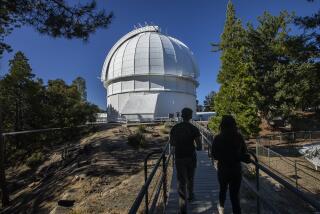The Art of Science -- Big or Small : The lesson of Hubble in the post-Cold War epoch
- Share via
“Are Two Labs Too Many?” asks the prestigious magazine Science. The labs in question, each with an annual budget of $1 billion, are the Lawrence Livermore National Laboratory and the Los Alamos National Laboratory. In the October issue, Science staff writer Christopher Anderson claims that “although official explanations cite the value of competition in science, the real reason (we have two weapons research labs) is that 40 years ago Edward Teller and Los Alamos National Laboratory founder Robert Oppenheimer had a falling-out, and Teller moved to California to create a new weapons lab.”
There are some post-Cold War growth areas at the two labs: dismantlement of nuclear weapons, disposal of plutonium cores from obsolete bombs, environmental monitoring. But for the foreseeable future, weapons research proper will not go beyond computer simulation. Some of the work force hitherto engaged in nuclear weapons development will surely be out of jobs.
The question about the twin labs points to much broader questions about the direction American science will take in the years ahead. The most important of these is whether the contraction of weapons research will mean, as many expect, a parallel contraction in the relative importance of physics and, within physics, of what has been called called “the nuclear priesthood.” However intrinsically interesting the physics research agenda of 1993, it’s hard to imagine, in the current environment, the federal government again building a laboratory for a ranking physicist as it did for Teller.
The competition between physics and other branches of science for public research money overlaps, to some extent, with the competition between big science and little science and, to a smaller extent, with that between basic science and applied science. Perhaps the biggest project in basic science ever conceived was the superconducting super collider, an $11-billion physics research project that Congress killed last October after spending $2 billion on it. Some scientists despaired at the demise of this bold attempt to discover nothing less than the fundamental physics of the universe. Others, however, secretly hoped that federal research money might begin to be spread more widely.
The Hubble space telescope, at $1.5 billion, is a much less costly project than the superconducting super collider, but the research it serves--understanding the origins of the cosmos--is no less basic. Dependent as it is, in part, on rocket technology, the orbiting telescope also owes a debt to the Cold War; but its critics need to remember that the broad project of which it is a part is much older than nuclear standoff. Edwin P. Hubble, the astronomer for whom it is named, did his pioneering work at the Mt. Wilson Observatory in the 1920s. His research led to the “Big Bang” theory of the expanding universe.
The just-concluded $629-million Hubble rescue mission, flawlessly executed as it was, will now yield to seven weeks of nail-biting suspense as the world waits to see if the repairs actually work. If they do, then the big science of the Cold War era will begin paying 15 years (the anticipated active life of the telescope) of major annual dividends to the smaller science of the post-Cold War era. However painful the adjustments that lie ahead, there is much here to be proud of, grateful for and even, cautiously, optimistic about.






